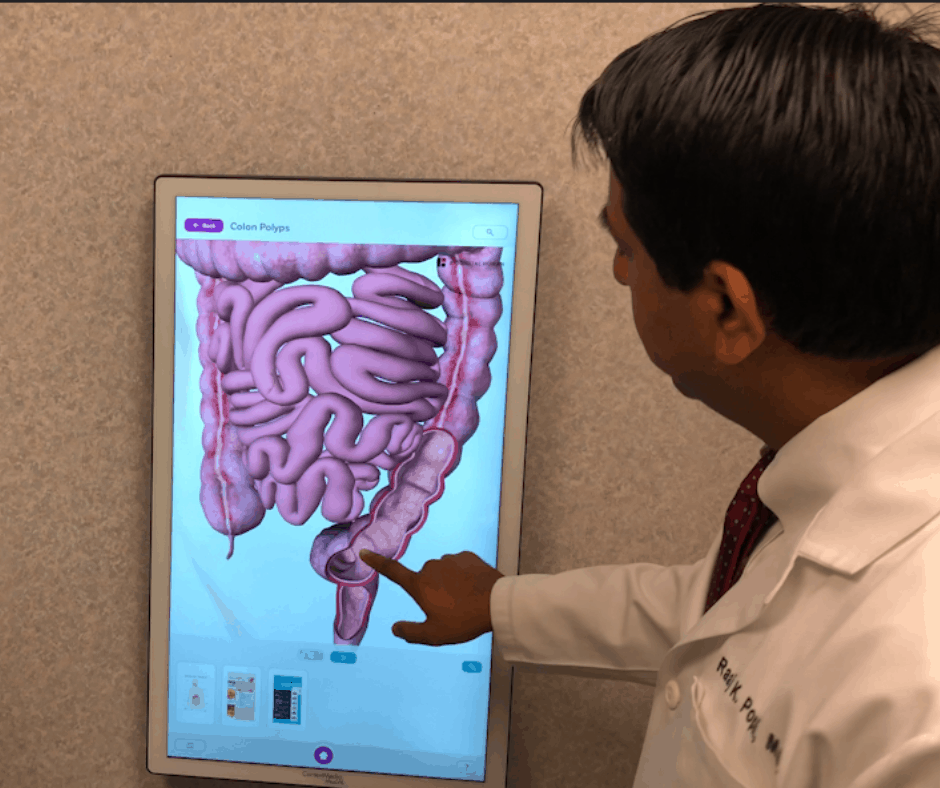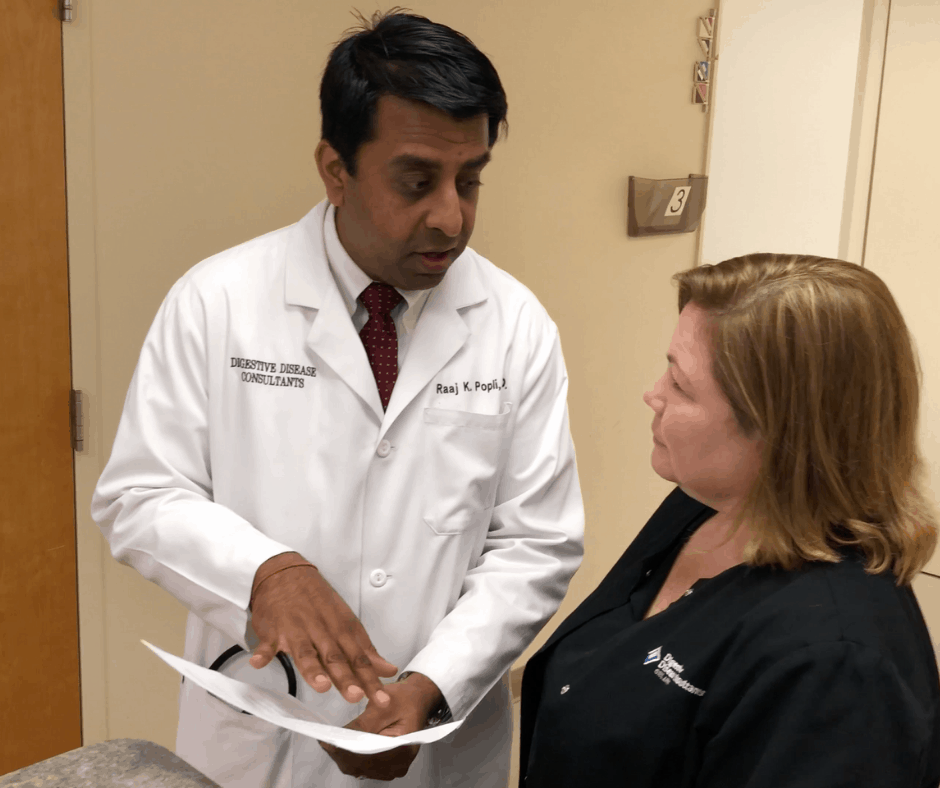Gastroesophageal reflux disease (GERD), or reflux, is one of the most common digestive disorders. It happens when a muscle at the bottom of the esophagus does not shut properly and the contents of the stomach leak back up, or reflux, into the esophagus and cause irritation. GERD affects about 20% of the U.S. adult population.
Raaj K. Popli, M.D., focuses much of his practice on treating patients with GERD and raising awareness about the importance of colon cancer screenings.
Dr. Popli says many patients living with GERD are suffering from symptoms frequently.
GERD is characterized by heartburn, that intense irritating sensation in the chest or throat. It can be caused by several conditions such as hiatal hernia or lifestyle choices such as smoking.
What Causes GERD?

GERD flares up when gastric acid from your stomach comes up into your food pipe (esophagus). The lower esophageal sphincter (LES) is a muscle at the bottom of the esophagus, which opens to let food in and closes to keep food down in the stomach. When the LES relaxes too often or for too long, acid backs up into your esophagus and causes irritation.
Lifestyle habits that may cause GERD include:
- Being overweight
- Overeating
- Eating foods such as citrus, chocolate, fatty foods, or spicy foods
- Caffeine consumption
- Drinking alcohol
- Smoking
- Using aspirin and over-the-counter pain and fever medicines
- Taking nonsteroidal anti-inflammatory drugs (NSAIDs) such as ibuprofen and naproxen
Health problems that can lead to heartburn include:
- Swelling of your stomach lining (gastritis)
- Ulcers on the lining of your stomach, esophagus, or the first part of your small intestine (duodenum)
- An allergic condition in the esophagus (eosinophilic esophagitis)
What are the Symptoms of GERD?
 Heartburn, or acid indigestion, is the most common symptom of GERD. It usually feels like a burning chest pain, starting near the breastbone and moving up to the neck and throat. Other signs and symptoms of GERD include:
Heartburn, or acid indigestion, is the most common symptom of GERD. It usually feels like a burning chest pain, starting near the breastbone and moving up to the neck and throat. Other signs and symptoms of GERD include:
- Pain when swallowing
- Regurgitating food or sour liquid
- Nausea or vomiting
- Bad breath
- Breathing problems
Nighttime acid reflux affects many people with GERD while they are trying to sleep. 70 percent of GERD patients in one study reported having nighttime acid reflux at least once a week. The condition can result in:
- Discomfort
- Disrupted sleep
- A bitter taste in the mouth from reflux acid
- Chronic cough
- New or worsening asthma
Dr. Popli says heartburn and regurgitation are two of the most common effects of GERD, but he also sees other symptoms while treating his patients.
“There can be a number of other symptoms associated with reflux as well, including abdominal pain, sore throat, even things such as vocal cord dysfunction, and even dental problems associated with it as well,” he explains.
How is GERD Diagnosed?
Your physician will conduct a physical exam and ask about your symptoms. He or she might use any of the following procedures to check for GERD complications:
- Barium swallow: You drink a barium solution, then a physician examines your upper digestive tract using X-ray imaging
- Upper endoscopy: a flexible tube with a tiny camera is threaded into your esophagus to analyze it and possibly collect a sample of tissue (biopsy)
- Esophageal manometry: a flexible tube threaded into your esophagus measures the strength of your esophageal muscles
- Esophageal pH monitoring: a monitor is inserted into your esophagus to learn if and when stomach acid enters it
What are the Treatment Options for GERD?
Lifestyle modifications and over-the-counter medications are the first treatment options to address symptoms of GERD. If you don’t experience relief within a few weeks, your physician might recommend you take a prescription medication or have surgery.
Dr. Popli warns patients to take GERD seriously. He adds, “It’s important to follow up with your physician, because there can be some serious implications with reflux disease. These can include simple things such as damage to your esophagus that can lead to more serious things like even esophageal cancer.”
Lifestyle changes may reduce how often you experience acid reflux. These include:
- Maintaining a healthy body weight
- Quitting smoking
- Waiting at least three hours after eating before lying down
- Eating food slowly and chewing well
- Avoiding fried foods, tomato sauce, alcohol, chocolate, mint, garlic, onion, and caffeine which can trigger reflux
Over-the-counter medications include:
- Mylanta, Rolaids, and Tums antacids neutralize stomach acids to offer short-term relief.
- Medications to reduce acid production, known as H-2-receptor blockers, don’t act as quickly as antacids, but they provide longer relief and can decrease acid production from the stomach for up to 12 hours. These include cimetidine (Tagamet HB) and famotidine (Pepcid AC).
- Proton pump inhibitors block acid production and heal the esophagus. They are stronger than H-2-receptor blockers and allow time for damaged esophageal tissue to heal. Over-the-counter proton pump inhibitors include lansoprazole (Prevacid 24 HR) and omeprazole (Prilosec OTC, Zegerid OTC).
Prescription-strength treatments for GERD include:
- Prescription-strength H-2-receptor blockers
- Prescription-strength proton pump inhibitors
- Medication to strengthen the lower esophageal sphincter
Surgery and Other Procedures to Treat GERD
 Your doctor may recommend surgery if your GERD symptoms don’t improve with medications or changes to your lifestyle.
Your doctor may recommend surgery if your GERD symptoms don’t improve with medications or changes to your lifestyle.
Fundoplication
Fundoplication is the most common surgery for GERD, and it usually leads to long-term reflux control.
A surgeon performs fundoplication using a minimally invasive laparoscope, a thin tube with a tiny video camera. During the operation, the top of your stomach will be sewn around your esophagus to add pressure to the bottom of the esophagus and to reduce reflux. The wrapping of the top part of the stomach can be partial or complete.
Endoscopic Techniques
Endoscopic techniques, such as endoscopic sewing and radiofrequency, are used less frequently to help control GERD. Endoscopic sewing uses tiny stitches to tighten the sphincter muscle in your esophagus. Radiofrequency creates heat lesions, or sores, which help tighten your sphincter muscle.
If you have questions about Gastroesophageal reflux disease (GERD), contact us for more information.
